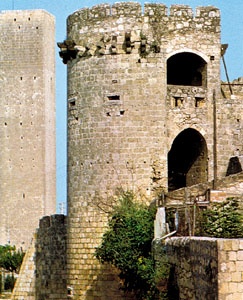Tarquinia
Italy
Etruscan Tárchuna, or Tarchna, Latin Tarquinii, formerly Corneto
 town and episcopal see, Lazio (Latium) regione, central Italy. It lies 4 miles (7 km) inland from the Tyrrhenian Sea, just north of Civitavecchia. The town developed out of the ancient Tárchuna (2 miles 【3 km】 northeast), which was one of the principal cities of the Etruscan confederation against Rome. Overcome by Rome in 311 BC, following wars in 394, 388, and 358–51, Tárchuna became the site of a Roman colony (Tarquinii) in 181 and received Roman citizenship in 90 BC. It declined during the late Roman Empire, and the old site was abandoned after the Lombard (6th century AD) and Saracen (8th century) invasions. Its inhabitants moved to a lower-lying site, known in medieval times as Corneto and from 1922 as Tarquinia.
town and episcopal see, Lazio (Latium) regione, central Italy. It lies 4 miles (7 km) inland from the Tyrrhenian Sea, just north of Civitavecchia. The town developed out of the ancient Tárchuna (2 miles 【3 km】 northeast), which was one of the principal cities of the Etruscan confederation against Rome. Overcome by Rome in 311 BC, following wars in 394, 388, and 358–51, Tárchuna became the site of a Roman colony (Tarquinii) in 181 and received Roman citizenship in 90 BC. It declined during the late Roman Empire, and the old site was abandoned after the Lombard (6th century AD) and Saracen (8th century) invasions. Its inhabitants moved to a lower-lying site, known in medieval times as Corneto and from 1922 as Tarquinia.The earliest archaeological remains at the original site of Tarquinia are 9th-century BC Villanovan (Iron Age) well tombs (tomb). The ancient city site was located on a hill by excavations carried out in 1934–38. Remains of an imposing circle of walls have been uncovered, as have the foundations of a great Etruscan temple known as the Ara della Regina, the decoration of which includes a terra-cotta group of winged horses in Hellenistic style that is considered a masterpiece of Etruscan art. The famous Etruscan necropolis of Tarquinii, situated on a ridge southwest of the ancient city, contains the most important painted tombs in Etruria (Etruscan Italy), mostly rock-cut chamber tombs dating from the 6th to the 4th century BC. The most famous is the Fowling and Fishing Tomb with its polychrome frescoes painted about 520 BC. The tombs of the Lionesses, of the Augurs, and of the Bacchantes (all 6th century BC) show dancing and banqueting scenes. The Tomb of the Triclinium is the most outstanding 5th-century painted tomb, and the Tomb of the Shields is a masterpiece of 4th-century painting. A distinctive 2nd-century painting tradition, rare in Etruria, is found in the paintings of the Tomb of the Cardinal. A serious conservation problem has arisen as many of the paintings have been attacked by moisture and fungus since the collection was opened to the public. A rich collection of articles from the necropolis is housed in the archaeological museum in the Palazzo Vitelleschi (1436–39) in modern Tarquinia, which also has many Romanesque buildings, notably the Church of Santa Maria de Castello, begun in 1121.
Modern Tarquinia's economic activities include tourism, paper mills, and agricultural industries. Pop. (2006 est.) mun., 16,058.
- marquis de Laplace, Pierre-Simon
- marquis de Louvois, François-Michel Le Tellier
- Marquis De Maillebois Desmarets, Nicolas
- marquis de Mirabeau, Victor Riqueti
- Marquis de Montalembert, Marc-René
- marquis de Montcalm, Louis-Joseph de Montcalm-Grozon
- marquis de Pérignon, Dominique-Catherine
- marquis de Rochefort-Lucay Rochefort, Victor-Henri
- Marquis de Ruvigny et Raineval Galway, Henri de Massue
- Marquis de Sade
- Marquis De Seignelay Colbert, Jean-Baptiste
- marquis de Torcy, Jean-Baptiste Colbert
- Marquis de Vauvenargues, Luc de Clapiers
- Marquis, Don
- Marquis Du Quesne Duquesne, Abraham
- marquise de Brinvilliers, Marie-Madeleine-Marguérite d'Aubray
- marquise de Maintenon, Françoise d'Aubigné
- marquise de Montespan, Françoise-Athénaïs de Rochechouart
- marquise de Pompadour, Jeanne-Antoinette Poisson
- Marquise de Prie, Jeanne-Agnes Berthelot de Pleneuf
- marquise de Rambouillet, Catherine de Vivonne
- marquise de Sévigné, Marie de Rabutin-Chantal
- Marquise du Châtelet, Gabrielle-Émilie Le Tonnelier de Breteuil
- Marquise du Deffand, Marie de Vichy-Chamrond
- marqués de Bedmar, Alonso de la Cueva